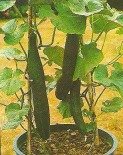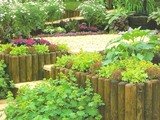|
Here are The Following Keys for the Plans
1. Incorporating worm compost bins is a great idea for a small garden. They can be positioned in an enclosed shady corner. 2. The water butts or tanks can be dependent on the house gutters. They can be joined to each other with tubes to increase capacity. In the bigger garden, water butts can be positioned close to the greenhouse. 3. The herb bed requires a lot of air and light exposure. 4. Vegetable beds must be position to get a lot of light and air for good growing efficiency. They are about 1m wide and are accompanied with concrete stepping-stone pathways between them for space consumption. The individual beds are placed in a north to south direction to get as much sun as possible. 5. A decorative fruit cage can be an optional feature to add in your vegetable garden layouts. It can be painted in black and decorated with some carved ornamental stones to give an attractive presence. 6. A small greenhouse can be included in your vegetable garden plans. It doesn’t matter how it’s positioned because it will need a lot of sun exposure. A great spot can be close to the house in order to take advantage of the house’s main heating system. 7. A bigger greenhouse can be positioned at the end of the garden to get some full sun exposure. 8. A small pool with some sloping rough edges and one filled with mud can be used to encourage wildlife in the garden. A secured metal grille must be well fitted below the water surface to provide a safety source for kids. 9. A big pond can create a bigger attraction for wildlife in the garden. 10. Bird Boxes can be positioned below the eaves, in dense shrubs and some evergreens. 11. Ladybird and lacewing nests are beneficial insects for the vegetable garden. You can attract these insects with some hollow stems and sticks hidden in dry sheltered spots. 12. Rotting logs are part of the pool habitat for beetles and dragonflies. They also help cover pots that are buried to supply homes for creatures like frogs. 13. Stone piles, plates, tiles and bottles are hidden under evergreen shrubs and away from the vegetables. They supply a good habitat source for the other tiny creatures. 14. Cordon or apples can be added if you like. They form a screen presence and can give you the ability to add more varieties into a small space. They most likely will need to be well pruned and supported. 15. Having a tree removed in a small garden is something to consider. A tree in a small garden tends to take up too much light and space. It can be removed if it’s not productive, protective or taken care of. 16. Removing the lawn can promote more productive space and there wouldn’t be any need for the use of a lawnmower. 17. A covered fence with climbers can be used to tone down and hide boundaries as well as to extend the gardening space. 18. Vegetables are thickly planted and mulched with the use of some small stepping stones for the pathway.
|









